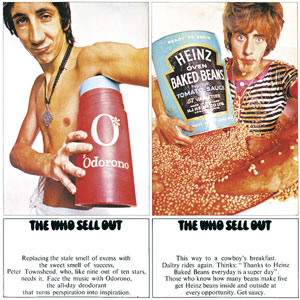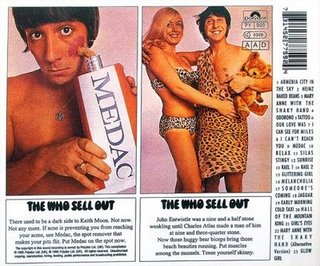
The Front Cover. It Was Actually Banned In Parts Of The States On Grounds Of Vulgarity.
As you probably know, The Who’s discography was extensively remastered and updated in the mid 90s, when the band celebrated its 30th birthday. A boxed set was released and every single album minus “My Generation” (owing to a legal dispute) was fortified with bonus tracks and big booklets including new liner notes and plenty of photographs. And none of these re-releases stood out so distinctly as this one.
You see – the original album (first issued in 1967) was structured as a pirate radio broadcast devoted solely to you-know-who, and the songs were interspersed with jingles and fake ads. But only on the first side. The ads disappeared from the second side, maybe because the songs themselves were more serious and they did not want to do the equivalent of painting a moustache on the Mona Lisa. Or – fans always wondered – because they had run out of ads and ideas.
This CD rerelease proved that there were enough ads to have filled the whole record, and that they were anything but substandard. The original album had 13 songs, and this CD features 23. These bonus tracks are as good as anything found on the original LP.
In addition to that conceptual approach that was finally realized when the CD materialized, the album had a series of characteristics that were very, very noticeable. The first was that Roger sang very few songs – absolutely everybody else sang one or two selections, and that is even so on the new bonus tracks (“Girl’s Eyes”, the last song Moon was to pen for The Who). Besides, the subject matter had a romantic bent that was not palpable on the previous albums (“My Generation” was diligent in avoiding these matters, in fact), and that would not be explored again until Pete went solo in the early 80s.

The Back Cover Of The CD. It Lists The Songs Included, Something The LP Omitted.
This makes sitting through the album a strange experience at first, as there is no fire and thunder but rather a sort of delicate pop approach that showcases their more ductile side. Well, that is not counting one of their best remembered songs, the ferocious “I Can See For Miles”. It was their first Top Ten hit in the US, and I frankly consider it the most menacing song I ever heard in my life. There is an undercurrent of aggression that maims more than a thousand screams or blows, and a stampeding threat of ferocity that is incredibly paradoxical: this, a somehow “subdued” song must have captured the vibe that characterized them onstage like no other composition, not even the numbers which are deliberately splenetic and raucous. Irish Jack (their number one fan) once described the effect they had when they came onstage by saying “The Who made you step back”. And this song does that. It is like a warning, enunciated in words that carry the weight of recrudescence with them.
I had to talk at such length about “I Can See For Miles” because I consider it their most accomplished achievement on record. It helped that Kit Lambert did a phenomenal production job, too. It was his tour-de-force, and it outbalanced every single mistake he made production-wise during their career. And that is saying a lot.
Elsewhere, the album had a couple of Entwistle compositions (something that was to characterize every album released after “A Quick One”), of which “Silas Stingy” was as hysterical as ever, and which anticipated the Uncle Ernie character sketch with its ominous horns and intonation.
Pete also contributed “Mary Anne With The Shaky Hand” and “Tattoo”. The former was yet another meditation on young desire and its multitudinous manifestations, afterthoughts and the self as felt through others. Or (in English), it was about a girl specialized in handjobs. Ha. For its part, Tattoo continued the exploration of adolescent themes in a very humorous light, and which resulted in one of the most enduring compositions on the album as far as live performances went.
The closer was a new “mini-opera”, which just set the scene to what was yet to come. That is the main value of “Rael”, actually. I have never been too keen on it, maybe because the meaning is far too obtuse and it is hard to make a connection with the song.
My overall take on the album is that it is probably the shiniest pop artifact they unearthed. It is not necessarily a step above the foregoing records, it is more of a step aside. It is good if you take it for what it is, and if you do buy it bear in mind that “I Can See For Miles” is an anomaly within the record, and not the prototype upon which the remaining tunes were based. If you understand that clearly, the first listens will be smoother, and it will grow faster on you. Because “Sell Out” is the biggest grower within their catalog.
Rating: 7.5

Pingback: It’s Hard (The Who) – Album Review (Part 2) | MusicKO
Pingback: The Iron Man (Pete Townshend) – Album Review (Part 2) | MusicKO